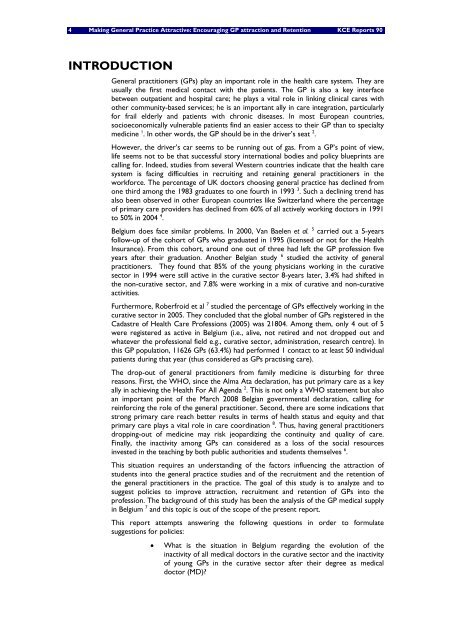Huisartsgeneeskunde: aantrekkingskracht en beroepstrouw ... - Lirias
Huisartsgeneeskunde: aantrekkingskracht en beroepstrouw ... - Lirias
Huisartsgeneeskunde: aantrekkingskracht en beroepstrouw ... - Lirias
Create successful ePaper yourself
Turn your PDF publications into a flip-book with our unique Google optimized e-Paper software.
4 Making G<strong>en</strong>eral Practice Attractive: Encouraging GP attraction and Ret<strong>en</strong>tion KCE Reports 90<br />
INTRODUCTION<br />
G<strong>en</strong>eral practitioners (GPs) play an important role in the health care system. They are<br />
usually the first medical contact with the pati<strong>en</strong>ts. The GP is also a key interface<br />
betwe<strong>en</strong> outpati<strong>en</strong>t and hospital care; he plays a vital role in linking clinical cares with<br />
other community-based services; he is an important ally in care integration, particularly<br />
for frail elderly and pati<strong>en</strong>ts with chronic diseases. In most European countries,<br />
socioeconomically vulnerable pati<strong>en</strong>ts find an easier access to their GP than to specialty<br />
medicine 1 . In other words, the GP should be in the driver’s seat 2 .<br />
However, the driver’s car seems to be running out of gas. From a GP’s point of view,<br />
life seems not to be that successful story international bodies and policy blueprints are<br />
calling for. Indeed, studies from several Western countries indicate that the health care<br />
system is facing difficulties in recruiting and retaining g<strong>en</strong>eral practitioners in the<br />
workforce. The perc<strong>en</strong>tage of UK doctors choosing g<strong>en</strong>eral practice has declined from<br />
one third among the 1983 graduates to one fourth in 1993 3 . Such a declining tr<strong>en</strong>d has<br />
also be<strong>en</strong> observed in other European countries like Switzerland where the perc<strong>en</strong>tage<br />
of primary care providers has declined from 60% of all actively working doctors in 1991<br />
to 50% in 2004 4 .<br />
Belgium does face similar problems. In 2000, Van Bael<strong>en</strong> et al. 5 carried out a 5-years<br />
follow-up of the cohort of GPs who graduated in 1995 (lic<strong>en</strong>sed or not for the Health<br />
Insurance). From this cohort, around one out of three had left the GP profession five<br />
years after their graduation. Another Belgian study 6 studied the activity of g<strong>en</strong>eral<br />
practitioners. They found that 85% of the young physicians working in the curative<br />
sector in 1994 were still active in the curative sector 8-years later, 3.4% had shifted in<br />
the non-curative sector, and 7.8% were working in a mix of curative and non-curative<br />
activities.<br />
Furthermore, Roberfroid et al 7 studied the perc<strong>en</strong>tage of GPs effectively working in the<br />
curative sector in 2005. They concluded that the global number of GPs registered in the<br />
Cadastre of Health Care Professions (2005) was 21804. Among them, only 4 out of 5<br />
were registered as active in Belgium (i.e., alive, not retired and not dropped out and<br />
whatever the professional field e.g., curative sector, administration, research c<strong>en</strong>tre). In<br />
this GP population, 11626 GPs (63.4%) had performed 1 contact to at least 50 individual<br />
pati<strong>en</strong>ts during that year (thus considered as GPs practising care).<br />
The drop-out of g<strong>en</strong>eral practitioners from family medicine is disturbing for three<br />
reasons. First, the WHO, since the Alma Ata declaration, has put primary care as a key<br />
ally in achieving the Health For All Ag<strong>en</strong>da 2 . This is not only a WHO statem<strong>en</strong>t but also<br />
an important point of the March 2008 Belgian governm<strong>en</strong>tal declaration, calling for<br />
reinforcing the role of the g<strong>en</strong>eral practitioner. Second, there are some indications that<br />
strong primary care reach better results in terms of health status and equity and that<br />
primary care plays a vital role in care coordination 8 . Thus, having g<strong>en</strong>eral practitioners<br />
dropping-out of medicine may risk jeopardizing the continuity and quality of care.<br />
Finally, the inactivity among GPs can considered as a loss of the social resources<br />
invested in the teaching by both public authorities and stud<strong>en</strong>ts themselves 6 .<br />
This situation requires an understanding of the factors influ<strong>en</strong>cing the attraction of<br />
stud<strong>en</strong>ts into the g<strong>en</strong>eral practice studies and of the recruitm<strong>en</strong>t and the ret<strong>en</strong>tion of<br />
the g<strong>en</strong>eral practitioners in the practice. The goal of this study is to analyze and to<br />
suggest policies to improve attraction, recruitm<strong>en</strong>t and ret<strong>en</strong>tion of GPs into the<br />
profession. The background of this study has be<strong>en</strong> the analysis of the GP medical supply<br />
in Belgium 7 and this topic is out of the scope of the pres<strong>en</strong>t report.<br />
This report attempts answering the following questions in order to formulate<br />
suggestions for policies:<br />
• What is the situation in Belgium regarding the evolution of the<br />
inactivity of all medical doctors in the curative sector and the inactivity<br />
of young GPs in the curative sector after their degree as medical<br />
doctor (MD)?

















